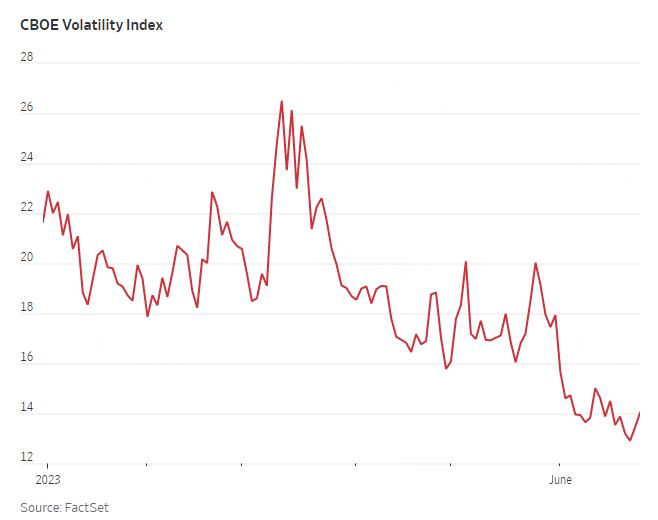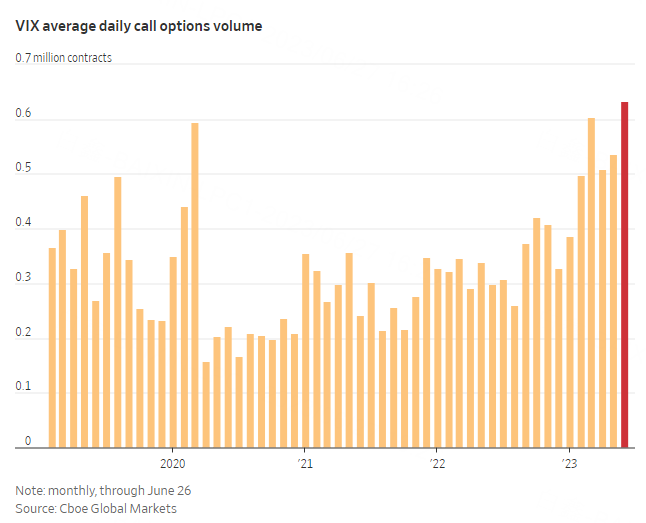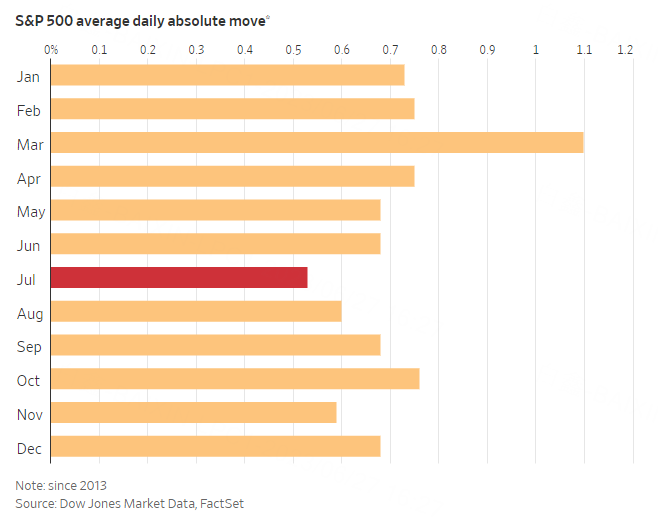Don't be fooled by the sleepy stock market.
Stocks have quietly climbed through the first half of the year, sending the S&P 500 up 13% and measures of market volatility to depths not seen since before the start of the Covid-19 pandemic.
The Cboe Volatility Index, or the VIX, has fallen to around 14, near the lowest levels since February 2020. Known as Wall Street's fear gauge, the index tracks the price of options often used to hedge against stock-market downturns.
Yet traders are pointing to a handful of signs, such as positioning in the options market and mammoth swings in some individual stocks, that suggest volatility has been brewing under the surface.
A boom of interest in artificial intelligence has led to a dizzying surge in the share prices of big tech stocks. The frenzy has helped the market value of the information technology sector climb about $1.9 trillion since the start of the year to more than $10 trillion, representing nearly half of the market's growth this year, according to Dow Jones Market Data.
Options wagers on the tech-led rally have also extended to other corners of the market, such as small-cap stocks. Even without a big market drawdown, should stocks begin moving in lockstep, that could boost turbulence in the broader market.
Traders are piling into wagers that would profit if that occurred. More call options tied to the VIX have changed hands on an average day in June than in any other month on record, according to Cboe Global Markets data.
Among the most actively traded options tied to the VIX in recent sessions have been those tied to the gauge jumping to as high as 47.5 or 30, a sign that some traders are positioning for more tumult later this year. The gauge typically moves in the opposite direction of stocks, making a bullish bet on the VIX akin to a bearish bet on stocks.
So what's been driving the lull in the broader market? The economy's resilience has helped quell fears about a recession that dominated for much of last year, leading to a steady march higher for major indexes. Instead of worries about inflation and other economic data, investors have turned their focus to individual companies.
For instance, the monthly inflation data -- known for setting off fireworks in the stock market last year -- has led to relatively tepid reactions in recent months. Meanwhile, much of the jobs data has been stronger than expected.
That has left many investors with more optimism about the economy and markets.
"It's almost like a sweet spot," said Danny Kirsch, head of options at Piper Sandler.
It has now been more than three months since the S&P 500 has pulled back at least 3%, one of the longest such stretches since World War II, Deutsche Bank research shows. The average weekly move for the benchmark has been less than 1% in either direction since the end of March, according to FactSet. In late 2022, the index averaged swings of roughly 2.6% each week.
Others say technical dynamics in the stock and options market have pushed volatility lower. One measure of how tightly stocks within the S&P 500 are moving together, known as correlation, has fallen to some of the lowest levels on record in the past three months, according to Deutsche Bank, a sign that stocks and sectors are moving in dramatically different directions.
This "has been a key driver of lower index [volatility] and suggests a decline in the pricing of macro concerns," the firm's analysts wrote in a recent note to clients.
Correlations within stocks haven't been this low since late 2017 and early 2018, around the time a burst of volatility known as "Volmageddon" jolted markets. If stocks across the S&P 500 start moving in lockstep once again, that would drive volatility higher.
Daily market moves might also be blunted by an income-generation strategy that has grown on Wall Street. Investors are heavily selling call contracts, known as overwriting, to pocket premiums while giving buyers the right to buy shares at a specific price, by a specific date.
The trading forces options dealers -- Wall Street firms that profit from market-making fees -- to hedge their exposure by selling shares. Quiet markets have driven more interest in the strategy, perpetuating the calm, according to traders.
"There's massive, really relentless call overwriting in the market right now -- maybe the most extreme I've seen in my career," said Alex Kosoglyadov, managing director of global equity derivatives at Nomura.
While the economic picture has remained sanguine despite a flurry of rate hikes from the Federal Reserve, some analysts say Fed policy has yet to pressure the economy -- and stock market -- given how high inflation remains.
Real interest rates, the difference between nominal rates and inflation, are arguably not yet in restrictive territory. Further rate increases at coming Fed meetings could be the difference between a central bank accommodation and tightening, especially if price pressures continue to wane. That could unravel the rally and make investors more sensitive to macroeconomic data, a theme of 2022's bear market.
To be sure, seasonal factors could keep volatility quiet even with second-quarter earnings season approaching. The S&P 500 has moved an average of 0.53% a day in July over the past decade, the quietest month of the year according to Dow Jones Market Data. That compares with March's average daily move of 1.1%.
Even with a number of traders positioning for renewed fear, the seasonality of the summer creates "the perfect storm" for low volatility to persist, said Kosoglyadov.



Comments